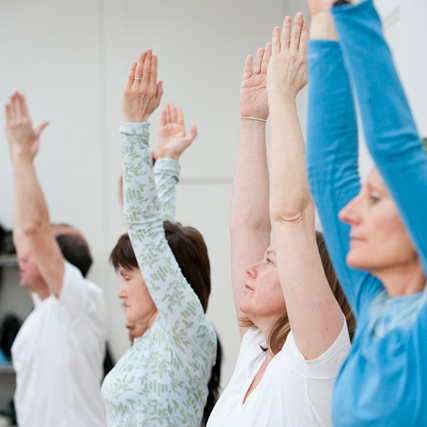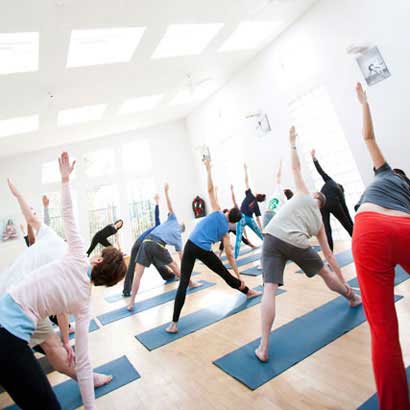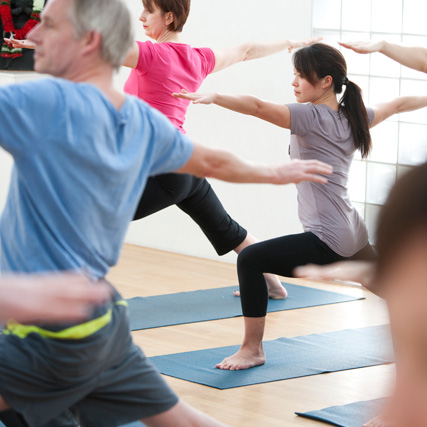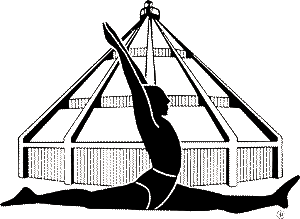Yoga became popular in the West in large part through the teaching of B.K.S. Iyengar. His method of learning yoga is now the most widely practised in the world.
Iyengar yoga involves performing yoga postures – known as asanas – with an emphasis on safety, detail, precision and bodily alignment. Practising Iyengar yoga can be a hugely positive influence on your health and wellbeing, helping you deal with the many mental and physical demands of modern life.
“Practice helps you to relax and energizes the body and mind, bringing vitality, flexibility, strength, concentration, self-confidence and mental calm.”
Iyengar yoga UK
Props make yoga safe and accessible to all
One of the key differences with other forms of yoga is that Iyengar yoga uses supports called ‘props’, like straps, blocks, cushions and blankets.
Props help make Iyengar accessible to all, so everyone can perform asanas correctly and safely – including beginners, and those with physical limitations or different ability or fitness levels.
Iyengar is a disciplined and systematic approach to yoga, with a diverse programme of asanas (you won’t repeat the same sequences every day). This variety in your practice helps prevent injury and overuse.
You will progress at a pace that suits you, and as your practice develops, teachers will start to introduce pranayama – breath control.
What can you expect at our yoga classes?
- A safe, methodical progression of yoga postures
- Technique – precision, alignment and awareness in performing the yoga postures
- Sequencing to develop strength, flexibility, stamina, concentration and relaxation
- Clear demonstration and explanation by well-qualified teachers
- Individual correction and adjustment by the teacher when necessary.
Attention to detail, with active help
Classes are challenging but the Iyengar method is a therapeutic approach that supports holistic health.
Compared to other forms of yoga you may have experienced, Iyengar yoga is notable for its emphasis on precise body alignment and the sequences in which asanas are practised. You hold postures for longer so that your muscles relax and lengthen, while your awareness is raised.
Rather than being left to simply ‘copy’ the teacher as best you can, in an Iyengar yoga class your teacher will actively help by explaining and correcting any misalignments.

“Even in simple asanas, one is experiencing the three levels of quest: the external quest, which brings firmness of the body; the internal quest, which brings steadiness of intelligence; and the innermost quest, which brings benevolence of spirit.”
B.K.S. Iyengar
The many benefits of Iyengar yoga
Tone muscles
The physical demand of holding a yoga pose builds strength in both body and mind.
Iyengar yoga engages the whole body bringing your attention not only to your muscles, but to your joints, opposing actions in the body, organs and even your skin. You are encouraged to identify where your muscles connect to other body parts and to engage these as well. The result is a full body toning experience and a refinement of awareness to the deeper workings of muscles within your body.
Discover a calmer mind
Iyengar yoga encourages you to focus on the precise alignment of your body in a pose. This takes a lot of concentration and can be surprisingly challenging for beginners. To maintain correct alignment you have to focus on what is happening in your body from moment to moment, letting go of distractions to achieve a type of meditation in action. The more you practise, the calmer your mind becomes both on and off the mat.
Breathe better
Iyengar yoga encourages us to become better acquainted with the breath and develop the body to support better breathing. It is impossible to breath deeply and well with a collapsed body posture so we learn how to strengthen the spine, broaden and deepen the chest to made good breathing possible. Breath control exercises – pranayama – then teaches us how to moderate the respiratory process and recognise the connection between the breath, the mind, and the emotions.

Find relief from pain
Many studies have supported the power of Iyengar yoga to relieve back and neck pain. By focusing attention on alignment, much of the slouching, hunching and muscle weakness that leads to back and neck pain can be overcome. Research studies have also supported the effectiveness of Iyengar yoga in relieving discomfort caused by conditions including spinal chord injuries and multiple sclerosis.
Increase Flexibility
You don’t need to be able to touch your toes to do Iyengar, however if you practice it, that may be one side effect you experience. Iyengar is a slow yet demanding practice that guides you into poses that stretch your body and are held for up to several minutes. Most students find that their range of movement is improved by the practice.
Improve posture
Through its focus on alignment, Iyengar yoga helps strengthen the muscles of the body responsible for posture. You learn to become aware of the balance between the left and right side of your body, the front, back and sides so that your skeletal structure is supported by your muscles without constriction or asymmetry. Mindful practice of the postures provides huge relief from postural discomfort and improves postural awareness.


Iyengar yoga Teachers Certification
Only certified teachers teach genuine Iyengar yoga. All of ours hold the Iyengar Yoga Teachers Certification Mark, a sign of excellence, clarity and depth of understanding. To use this logo, they have to be properly trained and maintain their development.








